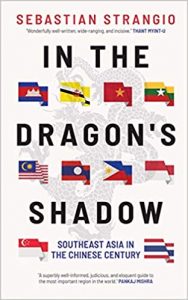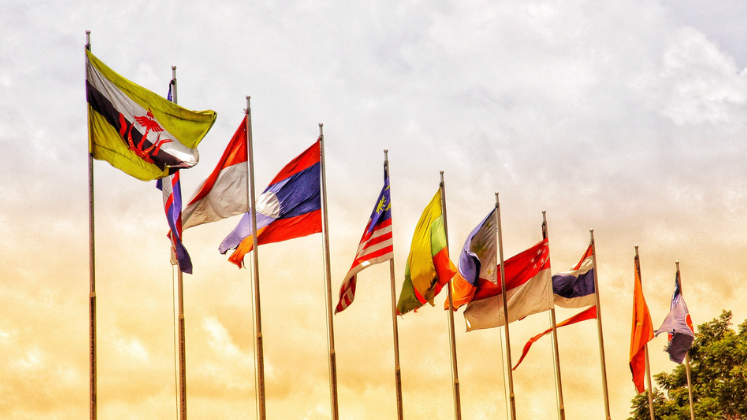In In the Dragon’s Shadow: Southeast Asia in the Chinese Century, Sebastian Strangio offers a new study exploring relations between China and the nations of Southeast Asia, not only examining China’s contemporary involvement in the region but also providing historical context and reflecting on the implications for the twenty-first century. This book sets a high standard for future scholarship in this area, finds Thomas Kingston, as the author’s grassroots knowledge and journalistic skills have crafted a convincing and informative work.
In the Dragon’s Shadow: Southeast Asia in the Chinese Century. Sebastian Strangio. Yale University Press. 2020.
 Find this book (affiliate link):
Find this book (affiliate link):![]()
Southeast Asia has long been overlooked in both mainstream media and academic literature, and whilst this is a professional and personal peeve of mine, it has real-world implications. With Southeast Asia historically used as a launchpad for trade with and missions to China, the twentieth century represented a changing approach to the region. Informed by the ideological binary of the Cold War, efforts to counter Chinese-backed Communist groups led to open and covert interventions in the majority of the nations that comprise Southeast Asia. A realpolitik approach led to some notorious decisions, such as the US backing of the anti-Communist purges in Indonesia that are linked to as many as one million deaths.
The end of the Cold War resulted in reduced Western involvement and recent years have seen this go even further with US policy shifting from Barack Obama’s ‘pivot to Asia’ to Donald Trump’s ‘America First’. Almost simultaneously we have seen the ‘Rise of China’; whilst Southeast Asia was one of the first regions targeted for investment by former Chinese leader Deng Xiaoping, recent developments now mean China can be seen as a real alternative to US and European Union (EU) ties. Some might see this scaling back of US influence and the shift in Chinese policy as luck, but as Seneca is alleged to have said, ‘luck is where preparation meets opportunity’. It is to this confluence of preparation and opportunity that Sebastian Strangio turns his attention in his excellent new book, In the Dragon’s Shadow.
Strangio’s work is a timely addition to both the literature considering China-Southeast Asia relations and the increasing number of approachable books that explore the economic and political dynamics of the rapidly changing world we live in. Timely is a key word here: firstly, as this work to some degree rectifies the neglect of Southeast Asia in terms of accessible scholarship. Secondly, as COVID-19, the presidential transition in the US and Brexit in the UK all develop, both China and Southeast Asia stand to play a key role in how the rest of the twenty-first century might evolve. It is into this opening that this book fits, aiming to illustrate not only China’s contemporary involvement across Southeast Asia, but also the historical context for this and what this might mean for the future.
The author is a long-term resident of Southeast Asia and has worked as a journalist throughout the region during most of its radical periods of change. I first came across his debut, Hun Sen’s Cambodia, just before moving to the country to work on human rights-related issues. I found this work an invaluable foundation to understanding the sometimes confusing and hectic developments I was witnessing and working on. Strangio’s grassroots knowledge and journalistic skills, not only working with sources but also crafting a convincing and informative written work, are apparent throughout this book. Very little about the reader is assumed, and I would propose that all that is necessary to understand and enjoy this book is an interest in the topics discussed.

The scene is set in Chapter One, a masterful laying of foundations for what follows. Here, recent Chinese politics are brought to life with vivid descriptions, whilst the importance of this on a global level is underlined. Not only is this key to appreciating the rest of the book, but it is vital to understand Strangio’s stance on China’s rise and aims in order to frame his findings. Strangio’s assessment is that China does not seek to ‘overturn and replace the existing US-backed global security order’, instead claiming that ‘Chinese attitudes are more ambivalent’. Ultimately, China wants ‘to reclaim something of the centrality it enjoyed in East Asia prior to its subjugation by the Western empires and imperial Japan in the nineteenth and twentieth centuries’.
A cursory glance at recent titles on China and news headlines demonstrates that this seemingly pragmatic stance is not without dispute or controversy. Whilst I feel it is a good thing, it should be emphasised that this work is not one that sees China as posing a direct ideological or military challenge to the ‘West’, but rather positions its rise as rooted in self-interest and historical dynamics. The context to this perspective is fleshed out in the remainder of Chapter One, which explores China’s multilayered historical relationship with Southeast Asia. The following chapter develops this further, albeit switching the focus from China’s interest in the region to the region’s interactions with and stance on China.
The remainder of the book follows a structure that considers the region nation by nation, starting with Vietnam before working through Cambodia and Laos, Thailand, Burma, Malaysia, Singapore, Indonesia and the Philippines. The book unpicks a complex web of ties, from ethnic Chinese communities in the region to China’s growing role as an ally and investor and, ultimately, an alternative to the US/EU support that often depends on democratisation and commitment to human rights. The nation-by-nation structure allows for a more detailed consideration of the differing experiences of the relationship between China and Southeast Asia. The exceptions to this approach (but not the treatment) are Cambodia and Laos, which get a combined chapter. Practically this makes sense as these nations lack the economic or political clout of populous Indonesia or small but mighty Singapore. Whilst in many other works this would mean less detail, this is not the case here.
In fact, this chapter was probably my favourite of them all. Whilst all of the chapters are strong in their own right, the section on Cambodia and Laos offers an insight into how radically China’s influence can change economic, political and social situations. Cambodia’s most notable examples include the rewriting of history, erasing the previous linking of China with the horrors of the Khmer Rouge as the country reorientates itself away from EU/US ties towards the allure of funding without ideological baggage (such as the requirements of democratisation and commitment to human rights). There is also an economic and material element to this realignment, usually linked to the Belt and Road Initiative. Whilst this initiative has been praised (usually by Chinese state media) for its role in development, the experiences of Cambodia and Laos demonstrate how the influx of investments, investors and workers is often accompanied by unofficial/private interests that have less than noble aims.
Amongst other issues, Strangio explains how unsafe Chinese-backed construction projects have led to the deaths of Cambodian workers, whilst the deeper pockets of Chinese investors have seen the pushing out of domestic vendors and businesses in Cambodia. This adds insight into what China’s attention means below the headline-grabbing level of trade deals and billion-dollar investments.
Laos, just across the border from China, illustrates this even further with the historical combination of poverty and war resulting in significant underdevelopment. New waves of Chinese investment and migration have meant a changing landscape and economy, with highways, railways and dams alongside Chinese business expansion. Laos’s position, whether in terms of geographical proximity, lack of development or ideological ties, means its experience with China is one to watch in the future. It is clear that Laos’s Communist Party has learnt a lot from China about shifting to economic liberalisation whilst maintaining power. China’s model of developing an agrarian nation into an economic powerhouse is surely desirable, whilst the poignant example of a border town’s meteoric rise, shabby contemporary state and potential resurrection demonstrates the uncertainty of such an economic relationship.
To any reader spurred by the inclusion of the Bruneian flag on the cover, hoping for a snapshot, I am sorry to disappoint as that is lacking – as is a discussion of East Timor. However, that in no way impairs the book and its contribution to the field. At the time of writing, out of the 106 books I read in 2020, this probably stands out as one of the most interesting and enjoyable, offering a well-balanced account. It avoids rose-tinted spectacles by recognising the nuanced reality of China’s relationships and history, but also avoids the reductionist take that sees China’s presence as invariably malign and undesirable. Informative yet digestible and combining accounts of geopolitical developments with the anecdotes of taxi drivers, this book sets a high standard for future works on the topic. It would be of interest to a wide range of readers, from those seeking to expand their knowledge of what the twenty-first century might mean on a global level to dedicated China watchers interested in understanding more about China’s impact.
- This article originally appeared at the LSE Review of Books.
- Image Credit: Image by Thuận Tiện Nguyễn from Pixabay
Please read our comments policy before commenting.
Note: This article gives the views of the authors, and not the position of USAPP– American Politics and Policy, nor of the London School of Economics.
Shortened URL for this post: https://bit.ly/316BkMc
About the reviewer
Thomas Kingston
Thomas Kingston is an independent researcher currently in pre-PhD limbo and a former Research Assistant and International Excellence Scholar at Renmin University of China. His current areas of interest include nationalism(s), colonialism, ideology as well as intellectual, economic and social history in the Southeast and East Asian contexts. He holds an MPhil in Philosophy, Religion and Culture from Renmin University and a MA in Pacific Asian Studies from SOAS, University of London, in addition to an LLB (Hons) in Law. He tweets at @thomasekingston and his website is www.thomasekingston.com






